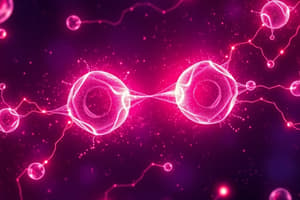Podcast
Questions and Answers
What is a characteristic of ionic bonds?
What is a characteristic of ionic bonds?
- Typically formed in gases
- Involves sharing of electrons
- Involves transfer of electrons (correct)
- Forms between nonmetals only
Which type of elements primarily forms covalent bonds?
Which type of elements primarily forms covalent bonds?
- Nonmetals with nonmetals (correct)
- Alkali metals only
- Noble gasses only
- Metals and nonmetals
What is true about the solubility of ionic compounds?
What is true about the solubility of ionic compounds?
- They are often soluble in water (correct)
- They are always insoluble in water
- Only polar ionic compounds are soluble
- They vary in solubility but are generally not soluble
What does lattice energy represent in ionic compounds?
What does lattice energy represent in ionic compounds?
How do ionic compounds conduct electricity?
How do ionic compounds conduct electricity?
What occurs when an atom loses one or more electrons?
What occurs when an atom loses one or more electrons?
Which of the following characteristics is typical of ionic compounds?
Which of the following characteristics is typical of ionic compounds?
What is the result of applying stress to an ionic compound?
What is the result of applying stress to an ionic compound?
What type of atoms are typically involved in the formation of ionic bonds?
What type of atoms are typically involved in the formation of ionic bonds?
How do ionic compounds behave in polar solvents like water?
How do ionic compounds behave in polar solvents like water?
Which factor does NOT affect the strength of ionic bonds?
Which factor does NOT affect the strength of ionic bonds?
What happens to ionic compounds when they are melted or dissolved in water?
What happens to ionic compounds when they are melted or dissolved in water?
Which of the following is an example of an ionic compound?
Which of the following is an example of an ionic compound?
Flashcards
Lattice Energy
Lattice Energy
The energy required to separate one mole of an ionic solid into its gaseous ions. Think of it as the strength of the bond holding the ions together.
Ionic Bond
Ionic Bond
A compound formed by the transfer of electrons from a metal to a nonmetal. This creates positively charged metal ions (cations) and negatively charged nonmetal ions (anions) that are attracted to each other.
Formula Unit
Formula Unit
The ratio of ions in an ionic compound. It represents the smallest repeating unit of the compound.
Oxidation States
Oxidation States
Signup and view all the flashcards
Covalent Bond
Covalent Bond
Signup and view all the flashcards
Anion
Anion
Signup and view all the flashcards
Cation
Cation
Signup and view all the flashcards
Crystal Lattice
Crystal Lattice
Signup and view all the flashcards
Ionization Energy
Ionization Energy
Signup and view all the flashcards
Electron Affinity
Electron Affinity
Signup and view all the flashcards
High Melting and Boiling Points
High Melting and Boiling Points
Signup and view all the flashcards
Solubility in Water
Solubility in Water
Signup and view all the flashcards
Study Notes
Definition and Characteristics
- Ionic bonding is a type of chemical bond involving the electrostatic attraction between oppositely charged ions.
- It forms when one or more electrons are transferred from one atom to another.
- The electron-losing atom becomes a positively charged ion (cation).
- The electron-gaining atom becomes a negatively charged ion (anion).
- This attraction holds ions together in a crystal lattice structure.
- Ionic compounds exhibit high melting and boiling points due to strong electrostatic forces between ions.
- They are generally solid at room temperature.
- Ionic compounds are often soluble in polar solvents like water.
- They conduct electricity when molten or dissolved in water, as ions are mobile.
Formation of Ionic Bonds
- Ionic bonds form when a metal atom loses one or more electrons, and a nonmetal atom gains those electrons.
- Metal atoms have relatively low ionization energies, making electron loss easier.
- Nonmetal atoms have high electron affinities, readily accepting electrons.
- This electron transfer creates oppositely charged ions.
Properties of Ionic Compounds
- High melting and boiling points: Strong electrostatic forces between ions require significant energy to overcome.
- Brittleness: Applying stress shifts ion layers, causing same-charge ion repulsion and crystal fracture.
- Solubility in water: Polar water molecules surround and dissolve ions, separating them from the lattice.
- Conductivity (in molten state or solution): Molten or dissolved ions move freely, allowing current flow.
- Crystalline structure: Regular, repeating ion arrangements form a crystal lattice.
Factors Affecting Ionic Bond Strength
- Charge of ions: Increased charge leads to stronger attraction, higher melting point.
- Size of ions: Smaller ions have stronger attraction, higher melting point.
- Crystal structure: Ion arrangement influences bond strength and properties.
Examples of Ionic Compounds
- Sodium chloride (NaCl): Table salt, formed by sodium losing an electron to chlorine.
- Magnesium oxide (MgO): Mineral, magnesium losing two electrons to oxygen.
- Potassium fluoride (KF): Industrial compound.
- Calcium chloride (CaCl₂): Common de-icer.
Differences Between Ionic and Covalent Bonds
| Feature | Ionic Bond | Covalent Bond |
|---|---|---|
| Electron transfer | Transfer of electrons | Sharing of electrons |
| Types of elements involved | Metals and nonmetals | Nonmetals with nonmetals |
| Attractive forces | Electrostatic attraction | Attraction between shared electrons and nuclei |
| Solubility in water | Often soluble | Varying solubility (polar covalent compounds often soluble) |
| Conductivity | Conducts electricity when molten or dissolved | Usually does not conduct electricity |
Important Concepts
- Lattice energy: Energy needed to separate one mole of ionic solid into gaseous ions.
- Oxidation states: Characteristic charges of ions involved in ionic bonds.
- Formula Unit: Represents the ratio of ions in an ionic compound.
Studying That Suits You
Use AI to generate personalized quizzes and flashcards to suit your learning preferences.




